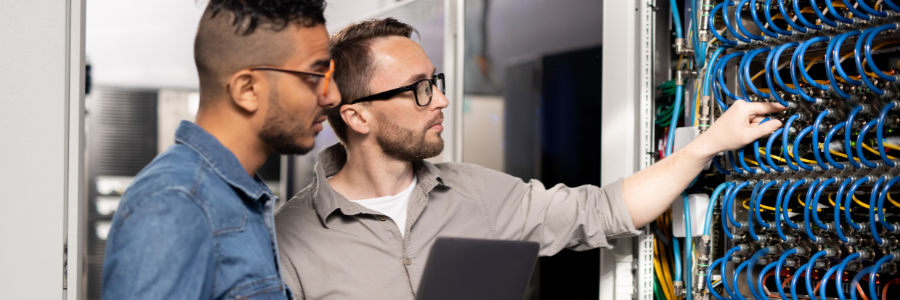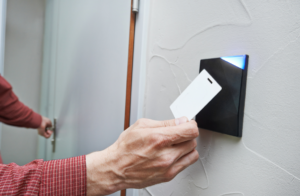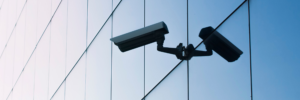The backbone of any enterprise is its network infrastructure. The reliability, speed, and security of your network can make or break your organization’s operations. As the lifeline of your enterprise security and network systems, it’s crucial to prioritize these best practices in cable networking:
Choose the Right Cabling Material
In the vast landscape of networking, the material of your cables is the silent workhorse. The type of cabling you choose directly impacts the efficiency, speed, and reliability of your entire network. Whether you’re setting up a new network or upgrading an existing one, understanding the strengths and applications of different cabling materials is paramount.
Copper: Known for its durability and reliability, copper cabling is a staple in many enterprise networks. It’s especially suited for shorter distances and offers a cost-effective solution for many businesses.
Fiber Optic: For longer distances and higher bandwidth needs, fiber optic cables are the go-to choice. They are less susceptible to electromagnetic interference and can transmit data at lightning-fast speeds.
Professional Installation is Key
While it might be tempting to cut corners with DIY solutions, professional installation ensures the longevity and reliability of your network. Adhering to recognized cable standards, such as ANSI/TIA/EIA-568 and ISO/IEC 11801, is crucial. These standards provide guidelines for cable length, diameter, color coding, labeling, pinout, and connector types. Following these standards will ensure that your network cables are compatible, reliable, and easy to troubleshoot. Moreover, using the appropriate tools and techniques for stripping, crimping, punching, and testing your network cables is essential to avoid damaging them or creating faults. Our team, equipped with the latest technology, certifies and tests our installations to exceed these industry standards, and also protects your investment with warranty and maintenance options. This not only ensures optimal performance but also minimizes potential issues down the road.
Regular Maintenance and Testing
Protecting your network goes beyond digital measures; the physical integrity of your cables is paramount. To safeguard against physical damage, it’s essential to monitor the cable condition and performance regularly. Inspect your network cables for signs of wear and tear, such as cuts, nicks, abrasions, kinks, or burns. Regular testing for faults or errors, like shorts, opens, splits, or crosstalk, is equally crucial. Utilize tools such as cable testers, toners, probes, or analyzers to measure network cable parameters, including resistance, capacitance, impedance, attenuation, or signal quality. Addressing any damaged or faulty network cables promptly is vital to prevent further complications or risks.
Prioritize Physical Security
Even with the right cables and organization, the physical security of your networking infrastructure remains paramount. External factors can pose significant threats to the integrity of your cables. To combat this, consider installing cable conduits, covers, or enclosures. These protective measures shield your cables from physical impact, moisture, dust, and even rodents. Electromagnetic interference from nearby power lines, generators, or other devices can also disrupt your network’s performance. To mitigate these effects, employ grounding and shielding techniques. These not only protect your cables but also ensure consistent and reliable data transmission.
Furthermore, always implement access control and security measures. This will prevent unauthorized or accidental tampering with your cables and networking equipment. By taking these precautions, you ensure that your networking equipment and cabling remain secure, protected from both environmental hazards and potential malicious activities.
Organization and Protection of Cabling Infrastructure
The foundation of a robust and secure network isn’t just about choosing the right cables; it’s about meticulous organization, protection against potential threats, and ensuring optimal performance.
A messy and tangled cable environment isn’t just an eyesore; it can lead to a plethora of problems. Poor airflow, overheating, difficulty in troubleshooting, and an increased risk of damage and interference are just a few of the challenges posed by disorganized cabling. To combat this, organize your cables with proper labeling, color-coding, routing, and bundling. Utilize cable management tools like racks, trays, panels, ties, clips, and hooks. These tools not only secure and support your cables but also ensure a neat and efficient cable environment. Additionally, be wary of excess cable length, sharp bends, and tight twists. Such practices can degrade cable performance and reduce its lifespan.
Stay Updated with Latest Technologies
The world of networking is ever-evolving. To ensure that your enterprise remains at the forefront, it’s essential to stay updated with the latest technologies and advancements in cable networking. This proactive approach ensures that your network is always equipped to meet the current and future demands of your organization.
Securing your enterprise goes beyond firewalls and antivirus software. The very foundation of your network, the cabling infrastructure, plays a pivotal role in ensuring the smooth and secure operations of your organization. By adhering to these best practices, you can ensure the success of your project, secure your network, and protect your investment for years to come. Find out how Data Link can help you secure your business so you can continue to meet the demands of your growing business.




